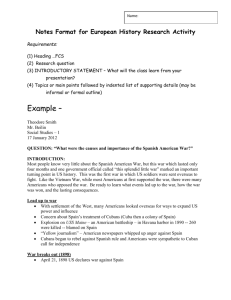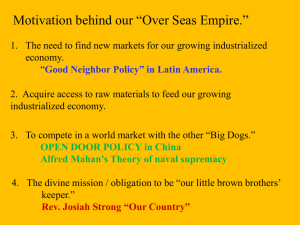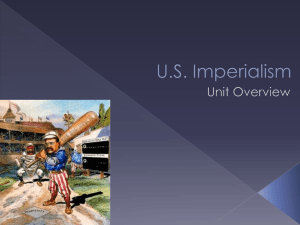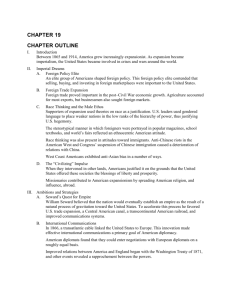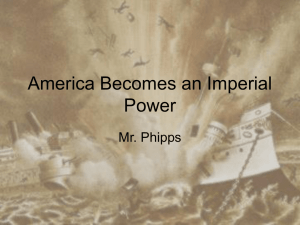Spanish American War Packet short
advertisement
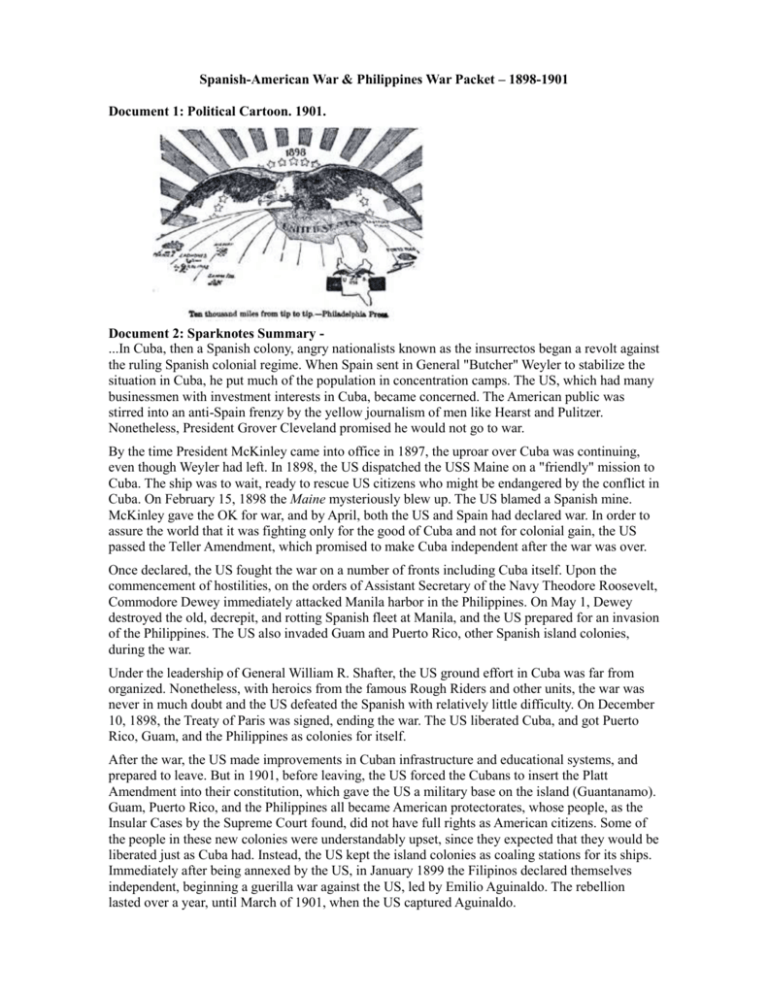
Spanish-American War & Philippines War Packet – 1898-1901 Document 1: Political Cartoon. 1901. Document 2: Sparknotes Summary ...In Cuba, then a Spanish colony, angry nationalists known as the insurrectos began a revolt against the ruling Spanish colonial regime. When Spain sent in General "Butcher" Weyler to stabilize the situation in Cuba, he put much of the population in concentration camps. The US, which had many businessmen with investment interests in Cuba, became concerned. The American public was stirred into an anti-Spain frenzy by the yellow journalism of men like Hearst and Pulitzer. Nonetheless, President Grover Cleveland promised he would not go to war. By the time President McKinley came into office in 1897, the uproar over Cuba was continuing, even though Weyler had left. In 1898, the US dispatched the USS Maine on a "friendly" mission to Cuba. The ship was to wait, ready to rescue US citizens who might be endangered by the conflict in Cuba. On February 15, 1898 the Maine mysteriously blew up. The US blamed a Spanish mine. McKinley gave the OK for war, and by April, both the US and Spain had declared war. In order to assure the world that it was fighting only for the good of Cuba and not for colonial gain, the US passed the Teller Amendment, which promised to make Cuba independent after the war was over. Once declared, the US fought the war on a number of fronts including Cuba itself. Upon the commencement of hostilities, on the orders of Assistant Secretary of the Navy Theodore Roosevelt, Commodore Dewey immediately attacked Manila harbor in the Philippines. On May 1, Dewey destroyed the old, decrepit, and rotting Spanish fleet at Manila, and the US prepared for an invasion of the Philippines. The US also invaded Guam and Puerto Rico, other Spanish island colonies, during the war. Under the leadership of General William R. Shafter, the US ground effort in Cuba was far from organized. Nonetheless, with heroics from the famous Rough Riders and other units, the war was never in much doubt and the US defeated the Spanish with relatively little difficulty. On December 10, 1898, the Treaty of Paris was signed, ending the war. The US liberated Cuba, and got Puerto Rico, Guam, and the Philippines as colonies for itself. After the war, the US made improvements in Cuban infrastructure and educational systems, and prepared to leave. But in 1901, before leaving, the US forced the Cubans to insert the Platt Amendment into their constitution, which gave the US a military base on the island (Guantanamo). Guam, Puerto Rico, and the Philippines all became American protectorates, whose people, as the Insular Cases by the Supreme Court found, did not have full rights as American citizens. Some of the people in these new colonies were understandably upset, since they expected that they would be liberated just as Cuba had. Instead, the US kept the island colonies as coaling stations for its ships. Immediately after being annexed by the US, in January 1899 the Filipinos declared themselves independent, beginning a guerilla war against the US, led by Emilio Aguinaldo. The rebellion lasted over a year, until March of 1901, when the US captured Aguinaldo. Document 3: Albert Beveridge. US Senate Speech. 1901. For more - https://www.mtholyoke.edu/acad/intrel/ajb72.htm “The Philippines are ours forever.... And just beyond the Philippines are China’s illimitable markets. We will not retreat from either. We will not repudiate our duty in the archipelago. We will not abandon our opportunity in the Orient. We will not renounce our part in the mission of our race, trustee under God, of the civilization of the world.” Document 4: Mark Twain Statement on the US conquest of the Philippines New York Herald [10/15/1900] http://www.historywiz.com/primarysources/marktwain-imperialism.htm I left these shores, at Vancouver, a red-hot imperialist. I wanted the American eagle to go screaming into the Pacific. It seemed tiresome and tame for it to content itself with the Rockies. Why not spread its wings over the Philippines, I asked myself? And I thought it would be a real good thing to do. I said to myself, here are a people who have suffered for three centuries. We can make them as free as ourselves, give them a government and country of their own, put a miniature of the American constitution afloat in the Pacific, start a brand new republic to take its place among the free nations of the world. It seemed to me a great task to which we had addressed ourselves. But I have thought some more, since then, and I have read carefully the treaty of Paris, and I have seen that we do not intend to free, but to subjugate the people of the Philippines. We have gone there to conquer, not to redeem. We have also pledged the power of this country to maintain and protect the abominable system established in the Philippines by the Friars. It should, it seems to me, be our pleasure and duty to make those people free, and let them deal with their own domestic questions in their own way. And so I am an anti-imperialist. I am opposed to having the eagle put its talons on any other land. Document 5: President McKinley Statement on Praying over the Philippine Islands In 1899 Americans divided sharply over whether to annex the Philippines. Annexationists and antiannexationists, despite their differences, generally agreed that the U.S. needed opportunities for commercial expansion but disagreed over how to achieve that goal. Few believed that the Philippines themselves offered a crucial commercial advantage to the U.S., but many saw them as a crucial way station to Asia. “Had we no interests in China,” noted one advocate of annexation, “the possession of the Philippines would be meaningless.” In the Paris Peace negotiations, President William McKinley demanded the Philippines to avoid giving them back to Spain or allowing a third power to take them. One explanation of his reasoning came from this report of a delegation of Methodist church leaders. The emphasis on McKinley’s religious inspiration for his imperialist commitments may have been colored by the religious beliefs of General James Rusling. But Rusling’s account of the islands, falling unbidden on the U.S., and the arguments for taking the islands reflect McKinley’s official correspondence on the topic. ... Hold a moment longer! Not quite yet, gentlemen! Before you go I would like to say just a word about the Philippine business. I have been criticized a good deal about the Philippines, but don’t deserve it. The truth is I didn’t want the Philippines, and when they came to us, as a gift from the gods, I did not know what to do with them. When the Spanish War broke out Dewey was at Hongkong, and I ordered him to go to Manila and to capture or destroy the Spanish fleet, and he had to; because, if defeated, he had no place to refit on that side of the globe, and if the Dons were victorious they would likely cross the Pacific and ravage our Oregon and California coasts. And so he had to destroy the Spanish fleet, and did it! But that was as far as I thought then. When I next realized that the Philippines had dropped into our laps I confess I did not know what to do with them. I sought counsel from all sides—Democrats as well as Republicans—but got little help. I thought first we would take only Manila; then Luzon; then other islands perhaps also. I walked the floor of the White House night after night until midnight; and I am not ashamed to tell you, gentlemen, that I went down on my knees and prayed Almighty God for light and guidance more than one night. And one night late it came to me this way—I don’t know how it was, but it came: (1) That we could not give them back to Spain—that would be cowardly and dishonorable; (2) that we could not turn them over to France and Germany—our commercial rivals in the Orient—that would be bad business and discreditable; (3) that we could not leave them to themselves—they were unfit for self-government—and they would soon have anarchy and misrule over there worse than Spain’s was; and (4) that there was nothing left for us to do but to take them all, and to educate the Filipinos, and uplift and civilize and Christianize them, and by God’s grace do the very best we could by them, as our fellow-men for whom Christ also died. And then I went to bed, and went to sleep, and slept soundly, and the next morning I sent for the chief engineer of the War Department (our map-maker), and I told him to put the Philippines on the map of the United States (pointing to a large map on the wall of his office), and there they are, and there they will stay while I am President! Source: General James Rusling, “Interview with President William McKinley,” The Christian Advocate 22 January 1903, 17. Reprinted in Daniel Schirmer and Stephen Rosskamm Shalom, eds., The Philippines Reader (Boston: South End Press, 1987), 22–23.


